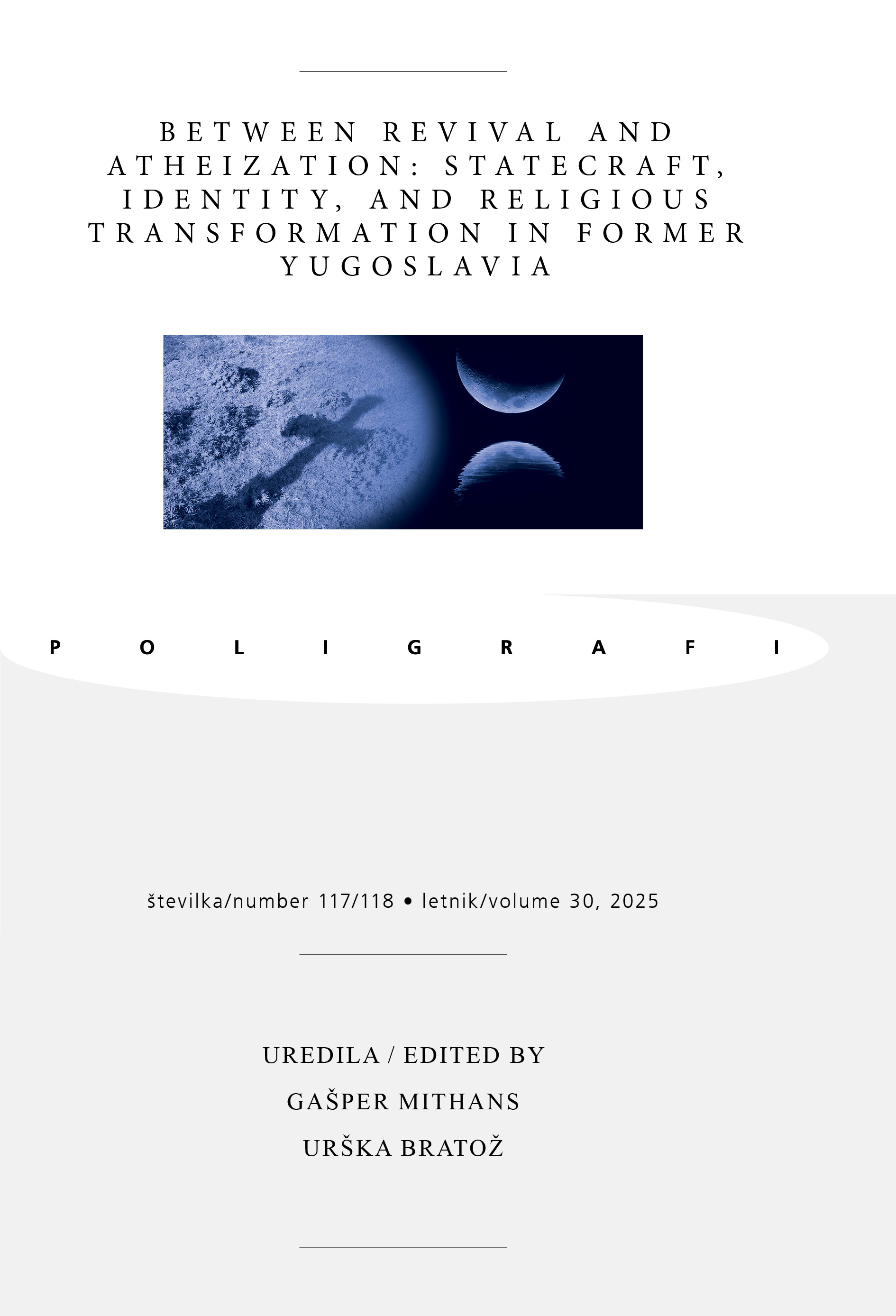State of Governance of Religious Communities in Former Yugoslavia and the Developments of the Bahá’í Community and Jehovah’s Witnesses
DOI:
https://doi.org/10.35469/poligrafi.2025.478Keywords:
religious community, church, conversion, Yugoslavia, communism, persecution, acceptanceAbstract
Yugoslavia officially recognized major religious communities, including the Roman Catholic and Orthodox Churches and the Islamic community, while around fifty smaller, unrecognized groups also existed by the 1960s. This study examines state laws and the development of two such communities – Jehovah’s Witnesses and the Bahá’í community. Despite a legal framework that guaranteed religious freedom, including the separation of church and state and protection from coercion, the reality was shaped by tensions between government policies and religious groups. This analysis explores how national identity, legal compliance, and ideological alignment with the state influenced the treatment of smaller religious communities within Yugoslavia’s broader framework of religious freedom.
Downloads
References
National Spiritual Assembly of the Bahá’ís of Austria, Vienna [Der Nationale Geistige Rat der Bahá’í in Österreich, Wien]:
Effendi, Shoghi. Religija sveta: Kratak pregled njenih ciljeva, učenja i istorije - World Religion: A Brief Overview of its Goals, Teachings and History, 1st ed. Belgrade, Serbia: Jugoslovenska Baha’i grupa, 1928.
Esselmont, John E. Bahá’u’lláh i Novo Doba - Bahá’u’lláh and the New Era. 1st ed. Belgrade, Serbia, 1933.
Various. “Baha’i Activities in Yugoslavia in 1973,” 1973. JUTA [Jugoslawischer und Tschechoslowakischer Ausschuss].
2009 Yearbook of Jehovah’s Witnesses, 2009. Lands of the Former Yugoslavia. Accessed March 11, 2025. https://www.jw.org/en/library/books/2009-Yearbook-of-Jehovahs-Witnesses/.
Alexander, Stella. “Religion in Yugoslavia Today.” Occasional Papers on Religion in Eastern Europe 10, no. 5 (1990): 7–13. Accessed March 10, 2025. https://digitalcommons.georgefox.edu/cgi/viewcontent.cgi?article=1511&context=ree&httpsredir=1&referer=.
Alexander, Stella. Church and State in Yugoslavia since 1945. Cambridge University Press, 2008.
Anonymous. “Martha Root En Zagrebo.” Konkordo, 3. ed. (March 1928): 7-8. DEC - dokumentacijski esperanto centar.
The Bahá’í World. Vol. 2. 1926-1928. New York: Bahá’í Publishing Committee, 1928. Accessed March 11, 2025. http://dl.bahai.org/bahai-world/the-bahai-world-vol02-1926-1928.pdf.
Basset Hornby, Helen. Lights of Guidance. New Delhi: Bahá’í Publishing Trust of India, 1996.
Calic, Marie-Janine. A History of Yugoslavia. Indiana: Purdue University Press, 2019.
Črnič, Aleš. V imenu Krišne: družboslovna študija gibanja Hare Krišna. Ljubljana: Fakulteta za družbene vede, 2005.
Črnič, Aleš. Na vodnarjevem valu: nova religijska in duhovna gibanja. Ljubljana: Fakulteta za družbene vede, 2012.
Đurić-Milovanović, Aleksandra. “Alternative Religiosity in Communist Yugoslavia: Migration as a Survival Strategy of the Nazarene Community.” Open Theology, 3 (2017): 447–57. https://doi.org/10.1515/opth-2017-0035.
Đurić-Milovanović, Aleksandra. “‘On The Road to Religious Freedom’: A Study of the Nazarene Emigration from Southeastern Europe to the United States.” Journal of Ethnography and Folklore 1-2 (2017): 5–27. https://dais.sanu.ac.rs/bitstream/handle/123456789/13960/On_the_Road_to_Religious_Freedom_a_Stud.pdf?sequence=1&isAllowed=y.
Encyclopaedia Britannica Book of the Year. Chicago, London Etc., 1996.
Garis, M. R. Martha Root: Lioness at the Treshold. Wilmette, Illinois: Baha’i Publishing Trust, 1983.
Käfer, Alex A. Die Geschichte Der Österreichischen Bahá’í-Gemeinde, 2nd ed. Wien: Esselmont Verlag, 2020.
Maran, Mirča. Rumunske verske zajednice u Banatu: Prilog proučavanju multikonfesionalnosti Vojvodine. Vršac: Visoka škola strukovnih strudija za obrazovanje vaspitača “Mihailo Pavlov”, 2011.
Mithans, Gašper. Jugoslovanski konkordat: Pacem in discordia ali jugoslovanski “kulturkampf.” Ljubljana: Inštitut za novejšo zgodovino, 2017.
Mithans, Gašper. “Religious Communities and the Change of Worldviews in Slovenia (1918-1991): Historical and Political Perspectives.” Annales: Anali za istrske in mediteranske študije = Annali di studi istriani e mediterranei = Annals for Istrian and Mediterranean Studies, Series Historia et Sociologia 30, no. 3 (2020): 415-34. https://doi.org/10.19233/ASHS.2020.27.
Mithans, Gašper. “Religious Conversions and Religious Diversification in Interwar Yugoslavia and Slovenia.” Occasional Papers on Religion in Eastern Europe 40, 2 (2020): 48-76. Accessed March 11, 2025. https://digitalcommons.georgefox.edu/ree/vol40/iss2/6/.
Mojzes, Paul. “Religious Liberty in Yugoslavia: A Study in Ambiguity.” Occasional Papers on Religion in Eastern Europe 6, no. 2 (1986): 23–41. https://digitalcommons.georgefox.edu/ree/vol6/iss2/2.
Mojzes, Paul. Religious Liberty in Eastern Europe and the USSR. Boulder: East European Monographs, 1992.
Nećak, Dušan, and Božo Repe. Oris sodobne obče in slovenske zgodovine: Učbenik za študente 4. letnika. Ljubljana: Oddelek za zgodovino Filozofske fakultete, 2003.
Radulović, Nemanja. “Esotericism Among the Serbian and Yugoslav Freemasonry in the Interwar Period.” In Freemasonry in Southeast Europe from the 19th to the 21st Centuries, edited by Slobodan G. Markovich, 191–218. Belgrade, 2020. Accessed March 10, 2025. https://www.academia.edu/45027955/Esoteric_Current_in_Serbian_and_Yugoslav_Interwar_Freemasonry.
Radulović, Nemanja. Gde ruža i lotos cveta: slika Indije u srpskoj književnosti i kulturi 19. i 20. veka. Beograd: Fedon, 2023.
Režek, Mateja. Med resničnostjo in iluzijo: 1948-1958: Slovenska in jugoslovanska politika v desetletju po sporu z Informbirojem. Ljubljana: Modrijan, 2005. https://www.dlib.si/details/URN:NBN:SI:DOC-LDWW2MCB.
Strajnar, Neža. “Zaprti zaradi verskega prepričanja: primeri krivično obsojenih pripadnikov različnih veroizpovedi v obdobju 1945–1955.” In V senci Beethovnove 3, 209-30. Ljubljana: Študijski center za narodno spravo, 2022.
Šircelj, Milivoja. Verska, jezikovna in narodna sestava prebivalstva Slovenije: Popisi 1921-2002. Ljubljana: Statistični urad Republike Slovenije, 2003. https://www.dlib.si/details/URN:NBN:SI:DOC-0TNJ0XB4.
Downloads
Published
How to Cite
Issue
Section
License
Copyright (c) 2025 Aleksandra Zibelnik Badii

This work is licensed under a Creative Commons Attribution 4.0 International License.
Open Access Policy and Copyright
This journal provides immediate open access to its content on the principle that making research freely available to the public supports a greater global exchange of knowledge. Users are allowed to read, download, copy, distribute, print, search, or link to the full texts of the articles, or use them for any other lawful purpose, without asking prior permission from the publisher or the author.
Authors who publish with this journal agree to the following terms:
- Authors retain copyright and grant the journal right of first publication with the work simultaneously licensed under the terms of the Creative Commons Attribution license (CC BY) that allows others to share the work with an acknowledgement of the work’s authorship and initial publication in this journal.
- Authors grant the publisher commercial rights to produce hardcopy volumes of the journal for sale to libraries and individuals.
- Authors are able to enter into separate, additional contractual arrangements for the non-exclusive distribution of the journal’s published version of the work (e.g., post it to an institutional repository or publish it in a book), with an acknowledgement of its initial publication in this journal.





